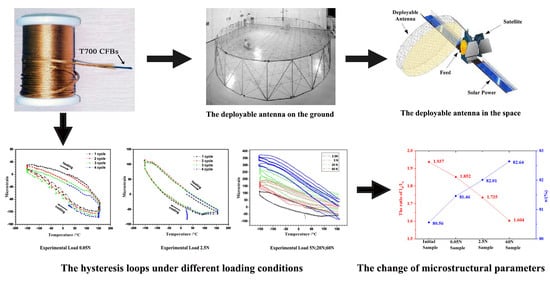Effect of Load on the Thermal Expansion Behavior of T700 Carbon Fiber Bundles
Abstract
:1. Introduction
2. Experimental Procedure
2.1. Materials and Specimen Preparation
2.2. Measurement of Coefficients of Thermal Expansion
2.3. Characterization
3. Results and Discussion
3.1. Effect of Experimental Loads on Thermal Expansion Behavior of Cfbs
3.2. Microstructural Analysis of Cfbs before and after the Thermomechanical Test
4. Conclusions
- (1)
- The T700 carbon fiber bundles that were parallel to the axis exhibited negative expansion characteristics within a temperature range between −150–+150 °C.
- (2)
- The strain curves of the specimen during the heating and the cooling cycles emerged as hysteresis loops during the thermal cycles. As the experimental load increased, the position of hysteresis loops exhibits a tendency to move down firstly and then move up gradually. The length of the sample also shows the state of shortening firstly and then elongating gradually.
- (3)
- The averages of the CTEs of T700 CFBs decreased gradually as the load increased, and the empirical approach for the prediction of the changes in the CTE can be expressed as an exponential relationship between the extent of variation and the experimental load.
- (4)
- The Raman spectra and the XRD analysis showed that the microstructural parameters of the T700 CFBs changed as the experimental load increased. This could be the primary cause for the negative CTE’s variation in the T700 CFBs.
Acknowledgments
Author Contributions
Conflicts of Interest
References
- Terada, M.; Bludworth, N.; Moore, J.; Sullivan, J. Deployable reflector system for satellite applications. In Proceedings of the SBMO/IEEE Mtt-S International Conference on Microwave and Optoelectronics, Brasilia, Brazil, 25 July 2005; pp. 647–649. [Google Scholar]
- Klooster, K.V.; Scialino, L.; Cherniavski, A.; Medzmariashvili, E. Large deployable antenna for various space applications. In Proceedings of the International Conference on Antenna Theory and Techniques, Kyiv, Ukraine, 24–27 May 2005; pp. 70–73. [Google Scholar]
- Meguro, A.; Harada, S.; Watanabe, M. Key technologies for high-accuracy large mesh antenna reflectors. Acta Astronaut. 2003, 53, 899–908. [Google Scholar] [CrossRef]
- Thomson, M.W. The AstroMesh deployable reflector. In Proceedings of the Antennas and Propagation Society International Symposium, Orlando, FL, USA, 11–16 July 2002; Volume 1513, pp. 1516–1519. [Google Scholar]
- Zhang, Y.Q.; Ru, W.R.; Yang, G.G.; Li, N. Deployment analysis considering the cable-net tension effect for deployable antennas. Aerosp. Sci. Technol. 2016, 48, 193–202. [Google Scholar] [CrossRef]
- Nie, R.; He, B.Y.; Zhang, L.H.; Fang, Y.G. Deployment analysis for space cable net structures with varying topologies and parameters. Aerosp. Sci. Technol. 2017, 68, 1–10. [Google Scholar] [CrossRef]
- Gamage, S.J.P.; Yang, K.; Braveenth, R.; Raagulan, K.; Kim, H.S.; Lee, Y.S.; Yang, C.M.; Moon, J.J.; Chai, K.Y. MWCNT coated free-standing carbon fiber fabric for enhanced performance in EMI shielding with a higher absolute EMI SE. Materials 2017, 10, 1351. [Google Scholar]
- Zhang, C.; Chen, M.; Paulson, S.C.; Rateick, R.G., Jr.; Birss, V.I. New insights into the early stages of thermal oxidation of carbon/carbon composites using electrochemical methods. Carbon 2016, 108, 178–189. [Google Scholar] [CrossRef]
- Farooq, U.; Myler, P. Ply level failure prediction of carbon fibre reinforced laminated composite panels subjected to low velocity drop-weight impact using adaptive meshing techniques. Acta Astronaut. 2014, 102, 169–177. [Google Scholar] [CrossRef]
- Bhagat, A.R.; Mahajan, P. Characterization and Damage Evaluation of Coal Tar Pitch Carbon Matrix Used in Carbon/Carbon Composites. J. Mater. Eng. Perform. 2016, 25, 1–8. [Google Scholar] [CrossRef]
- Du, Y.X.; Zhang, X.Y.; Liu, L.L.; Zhou, F.; Zhu, D.; Pan, W. Flexural behaviour of carbon textile-reinforced concrete with prestress and steel fibres. Polymers 2018, 10, 98. [Google Scholar] [CrossRef]
- Wu, Y.X.; Wang, X.W.; Zhang, T.; Liu, S.X. A preliminary study on thermal cycling damage of SiC/Al composites. Aerosp. Mater. Technol. 1992, 4, 62–66. (In Chinese) [Google Scholar]
- Liu, X.; Wu, M.E.; Ma, X.F.; Fang, H.F. Systematic Surface Deviation and Shape Control of a Large Mesh Reflector. In Proceedings of the Spacecraft Structures Conference, National Harbor, MD, USA, 13–17 January 2014; Volume 24, pp. 27–51. [Google Scholar] [CrossRef]
- Rahmat-Samii, Y.; Huang, J.; Lopez, B.; Lou, M.; Im, E.; Durden, S.L.; Bahadori, K. Advanced precipitation Radar antenna: Array-fed offset membrane cylindrical reflector antenna. IEEE Trans. Antennas Propag. 2005, 53, 2503–2515. [Google Scholar] [CrossRef]
- Wolff, E.G. Stiffness-Thermal Expansion Relationships in High Modulus Carbon Fibers. J. Compos. Mater. 1987, 21, 81–97. [Google Scholar] [CrossRef]
- Davis, G.T.; Eby, R.K.; Colson, J.P. Thermal Expansion of Polyethylene Unit Cell: Effect of Lamella Thickness. J. Appl. Phys. 1970, 41, 4316–4326. [Google Scholar] [CrossRef]
- Kobayashi, Y.; Keller, A. The temperature coefficient of the c lattice parameter of polyethylene; an example of thermal shrinkage along the chain direction. Polymer 1970, 11, 114–117. [Google Scholar] [CrossRef]
- Choy, C.L.; Chen, F.C.; Young, K. Negative thermal expansion in oriented crystalline polymers. J. Polym. Sci. Polym. Phys. 1981, 19, 335–352. [Google Scholar] [CrossRef]
- Sauder, C.; Lamon, J.; Pailler, R. The tensile behavior of carbon fibers at high temperatures up to 2400 °C. Carbon 2004, 42, 715–725. [Google Scholar] [CrossRef]
- Pradere, C.; Batsale, J.C.; Goyhénèche, J.M.; Pailler, R.; Dilhaire, S. Thermal properties of carbon fibers at very high temperature. Carbon 2009, 47, 737–743. [Google Scholar] [CrossRef]
- Kanagaraj, S.; Pattanayak, S. Measurement of the thermal expansion of metal and FRPs. Cryogenics 2003, 43, 399–424. [Google Scholar] [CrossRef]
- Praveen, R.S.; Jacob, S.; Murthy, C.R.L.; Balachandran, P.; Rao, Y.V.K.S. Hybridization of carbon-glass epoxy composites: An approach to achieve low coefficient of thermal expansion at cryogenic temperatures. Cryogenics 2011, 51, 95–104. [Google Scholar] [CrossRef]
- Schwarz, G. Thermal expansion of polymers from 4.2 K to room temperature. Cryogenics 1988, 28, 248–254. [Google Scholar] [CrossRef]
- Bruckmoser, K.; Resch, K.; Kisslinger, T.; Lucyshyn, T. Measurement of interdiffusion in polymeric materials by applying Raman spectroscopy. Polym. Test. 2015, 46, 122–133. [Google Scholar] [CrossRef]
- Khayyam, H.; Fakhrhoseini, S.M.; Church, J.S.; Milani, A.S.; Bab-Hadiashar, A.; Jazar, R.; Naebe, M. Predictive Modelling and Optimization of Carbon Fiber Mechanical Properties through High Temperature Furnace. Appl. Therm. Eng. 2017, 125, 1539–1554. [Google Scholar] [CrossRef]
- Liu, M.S.; Bursill, L.A.; Prawer, S.; Beserman, R. Temperature dependence of the first-order Raman phonon line of diamond. Phys. Rev. B 2000, 61, 3391–3395. [Google Scholar] [CrossRef]
- Ammar, M.R.; Rouzaud, J.N. How to obtain a reliable structural characterization of polished graphitized carbons by Raman microspectroscopy. J. Raman Spectrosc. 2012, 43, 207–211. [Google Scholar] [CrossRef]
- Ferrari, A.C.; Robertson, J. Interpretation of Raman spectra of disordered and amorphous carbon. Phys. Rev. B 2000, 61, 14095–14107. [Google Scholar] [CrossRef]
- Ferrari, A.C.; Rodil, S.E.; Robertson, J. Interpretation of infrared and Raman spectra of amorphous carbon nitrides. Phys. Rev. B 2003, 67, 1553061–15530620. [Google Scholar] [CrossRef]
- Tay, B.K.; Shi, X.; Tan, H.S.; Yang, H.S.; Sun, Z. Raman studies of tetrahedral amorphous carbon films deposited by filtered cathodic vacuum arc. Surf. Coat. Technol. 1998, 105, 155–158. [Google Scholar] [CrossRef]
- Huang, Y.; Young, R.J. Effect of fibre microstructure upon the modulus of PAN- and pitch-based carbon fibres. Carbon 1995, 33, 97–107. [Google Scholar] [CrossRef]
- Robinson, I.M.; Zakikhani, M.; Day, R.J.; Young, R.J.; Galiotis, C. Strain dependence of the Raman frequencies for different types of carbon fibres. J. Mater. Sci. Lett. 1987, 6, 1212–1214. [Google Scholar] [CrossRef]
- Wang, A.; Dhamenincourt, P.; Dubessy, J.; Guerard, D.; Landais, P.; Lelaurain, M. Characterization of graphite alteration in an uranium deposit by micro-Raman spectroscopy, X-ray diffraction, transmission electron microscopy and scanning electron microscopy. Carbon 1989, 27, 209–218. [Google Scholar] [CrossRef]
- Tuinstra, F.; Koenig, J.L. Characterization of Graphite Fiber Surfaces with Raman Spectroscopy. J. Compos. Mater. 1970, 4, 492–499. [Google Scholar] [CrossRef]
- Li, D.; Wang, H.; Wang, X. Effect of microstructure on the modulus of PAN-based carbon fibers during high temperature treatment and hot stretching graphitization. J. Mater. Sci. 2007, 42, 4642–4649. [Google Scholar] [CrossRef]
- Northolt, M.G.; Veldhuizen, L.H.; Jansen, H. Tensile deformation of carbon fibers and the relationship with the modulus for shear between the basal planes. Carbon 1991, 29, 1267–1279. [Google Scholar] [CrossRef]
- Ogale, A.A.; Lin, C.; Anderson, D.P.; Kearns, K.M. Orientation and dimensional changes in mesophase pitch-based carbon fibers. Carbon 2002, 40, 1309–1319. [Google Scholar] [CrossRef]
- Manocha, L.M.; Bahl, O.P. On the relation between Young’s modulus and orientation in carbon fibres. Fibre Sci. Technol. 1982, 17, 221–226. [Google Scholar] [CrossRef]
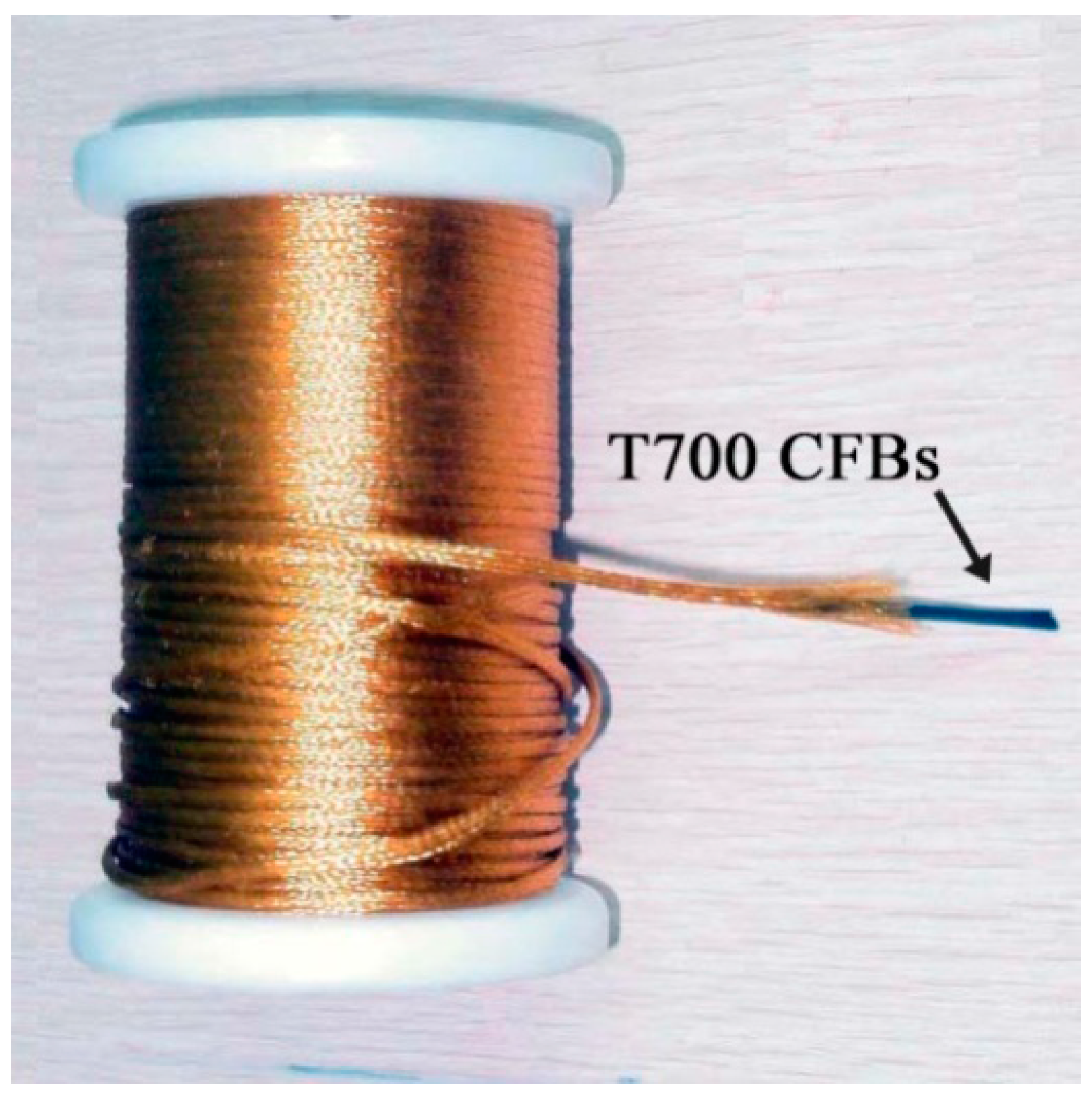

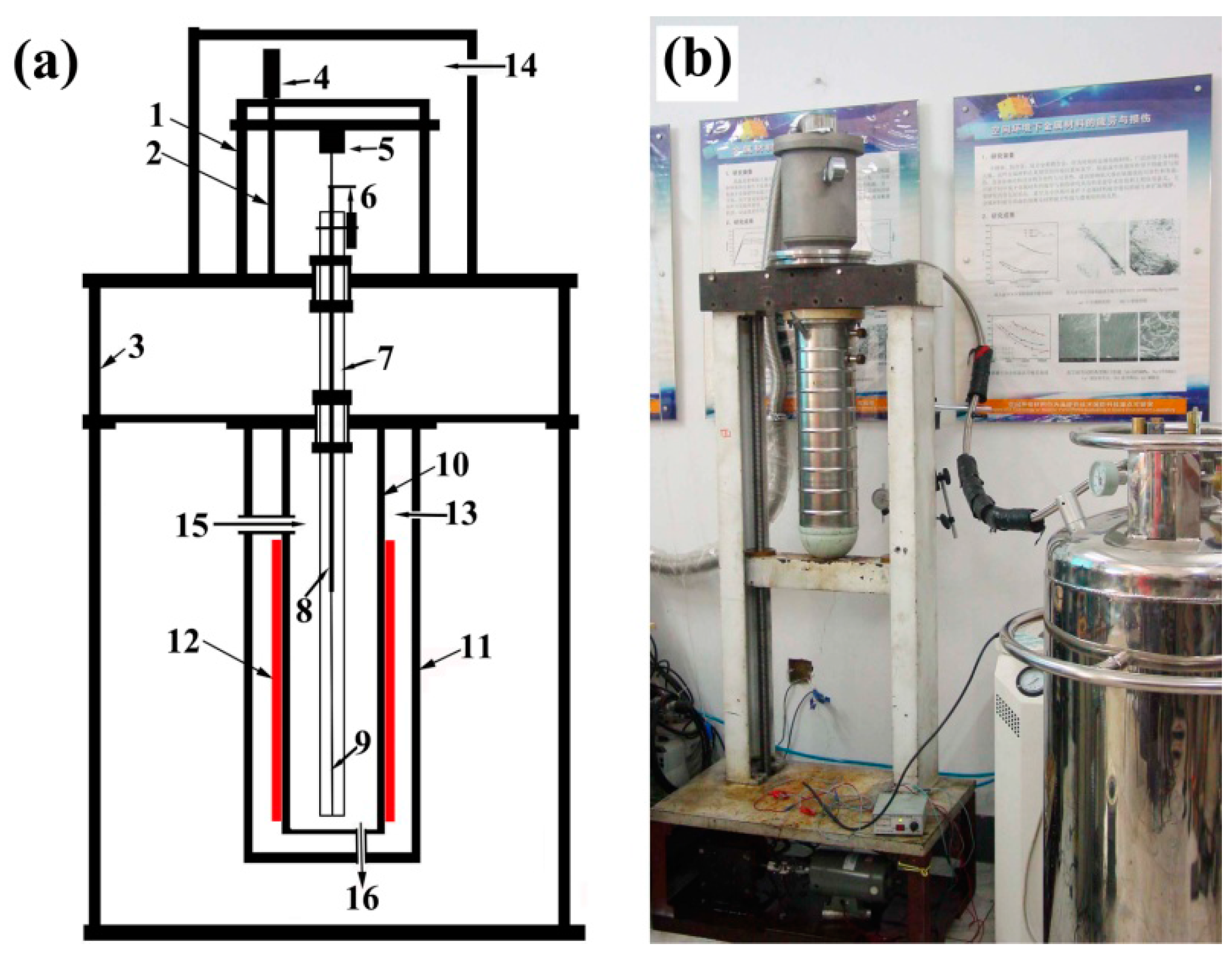
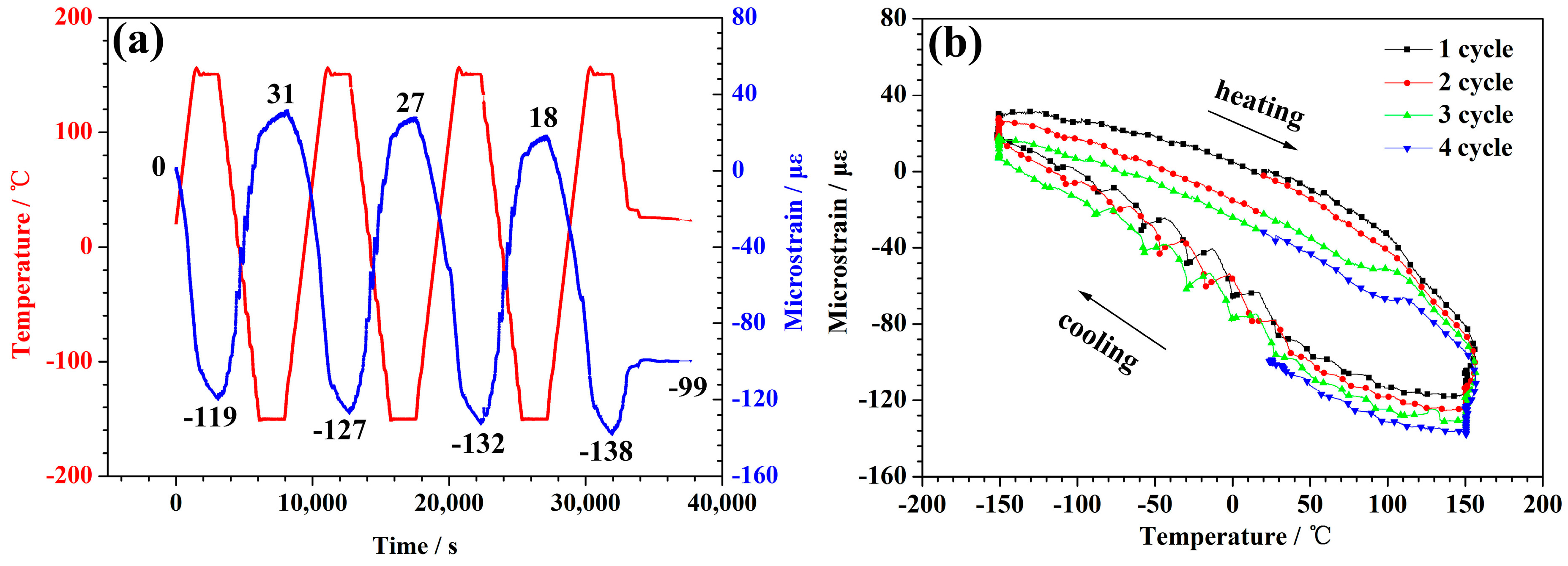

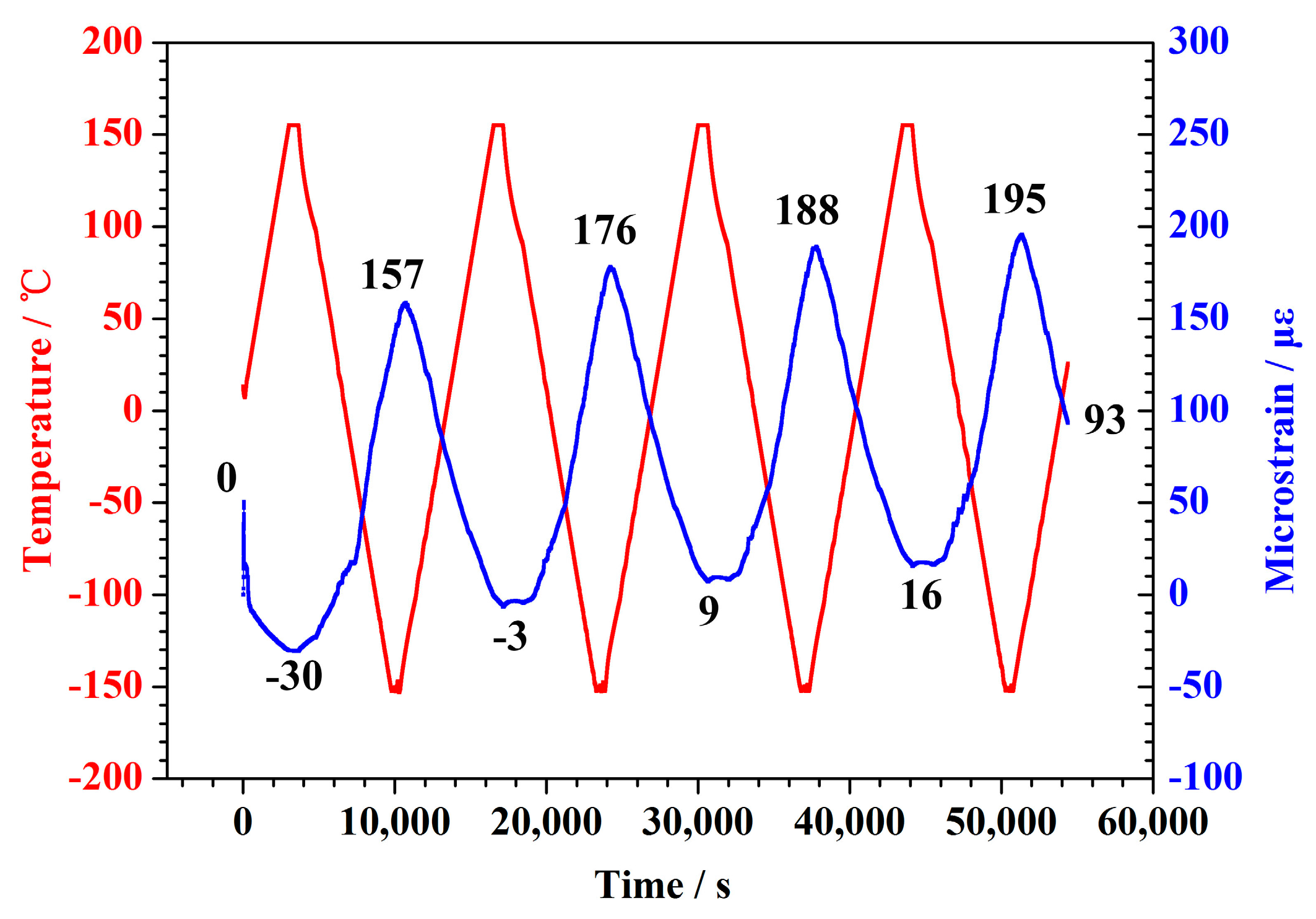
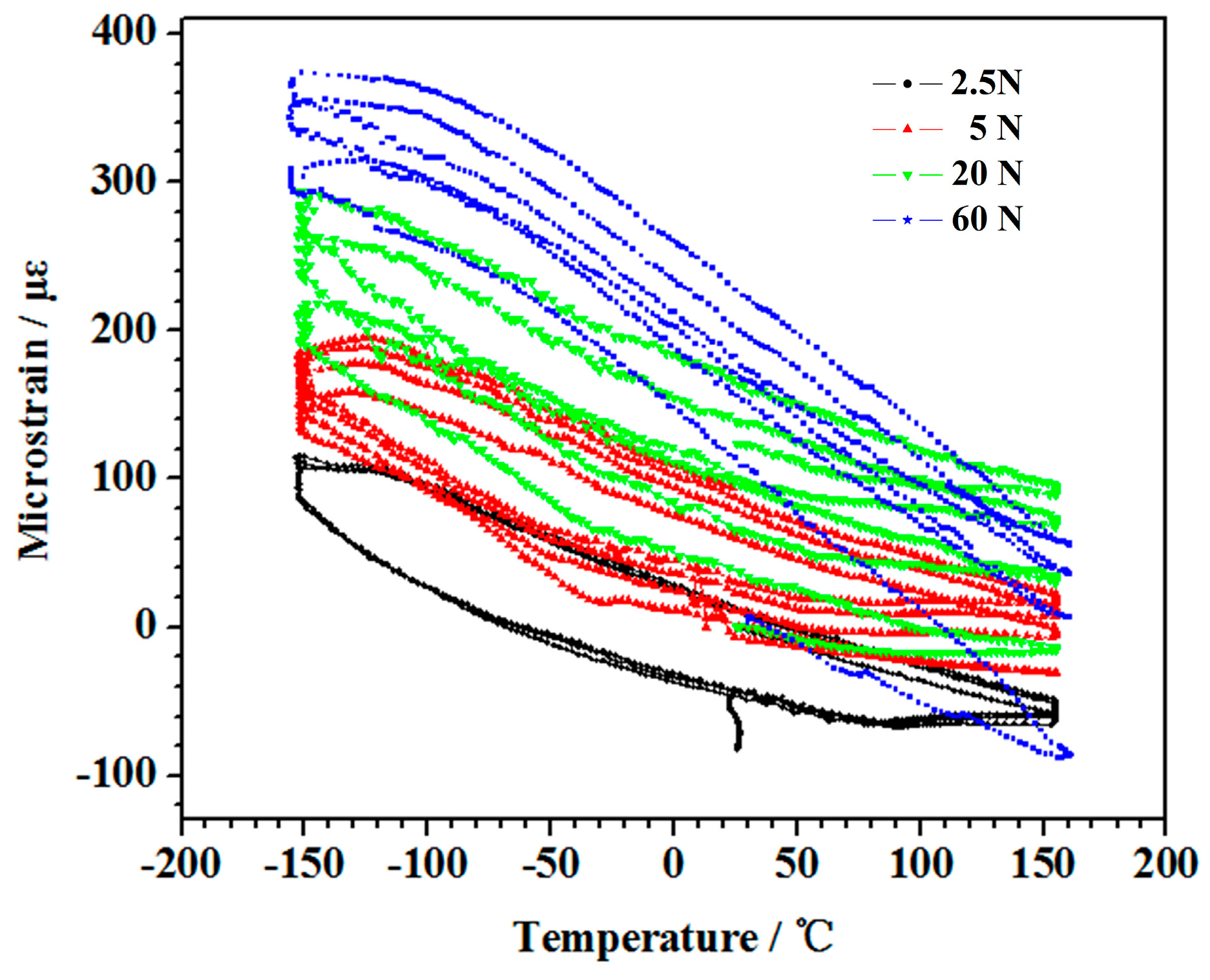
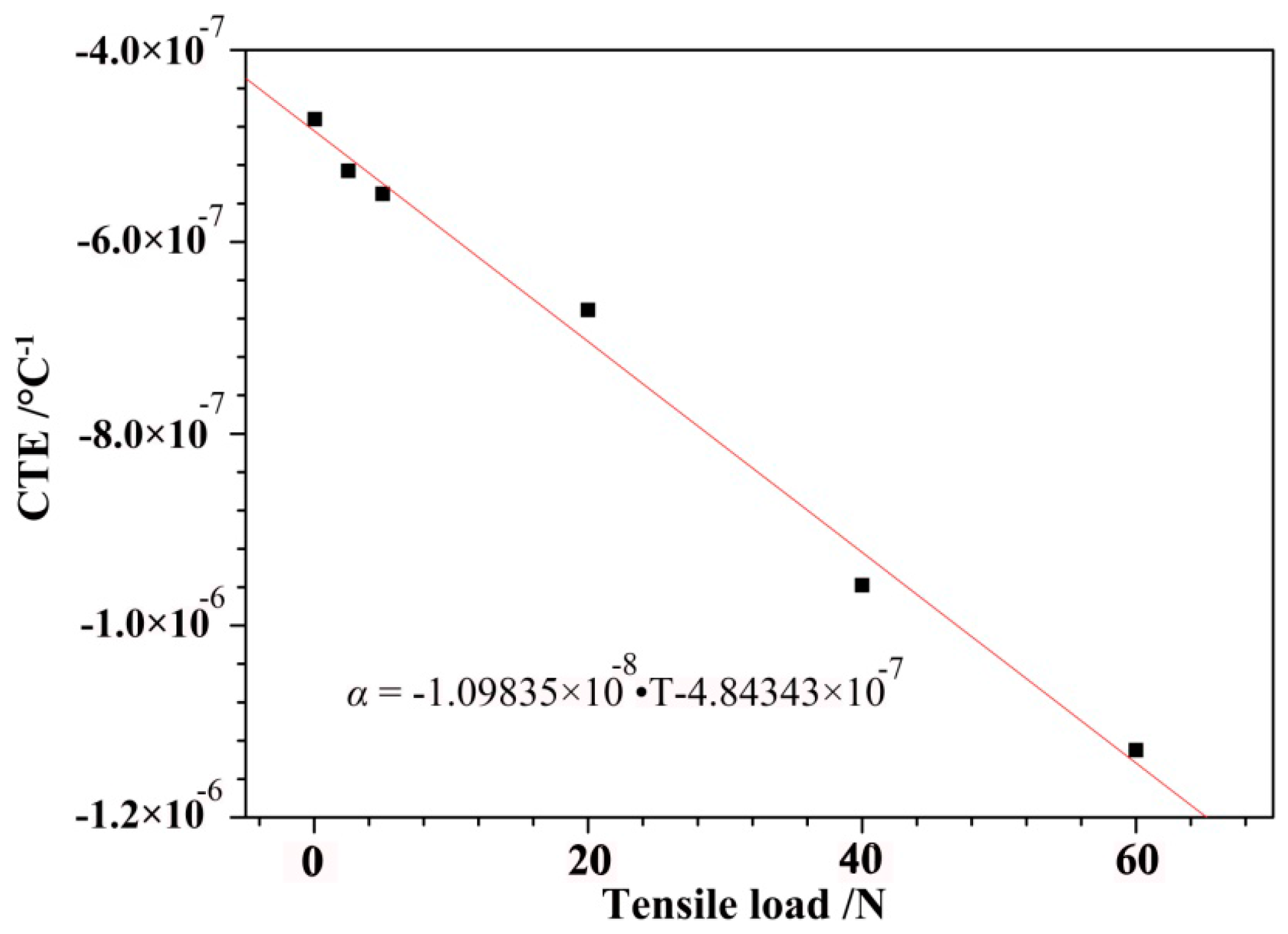
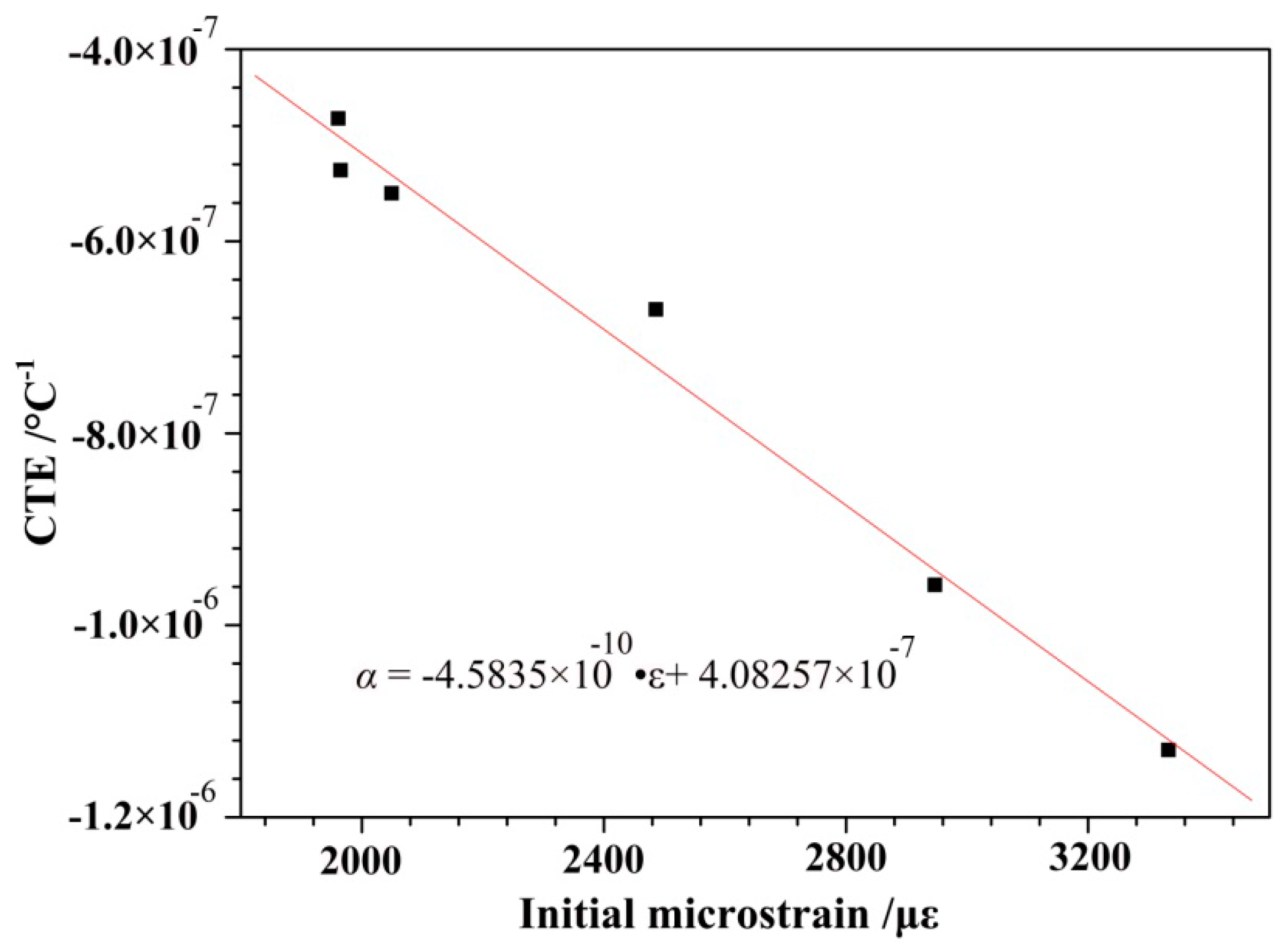

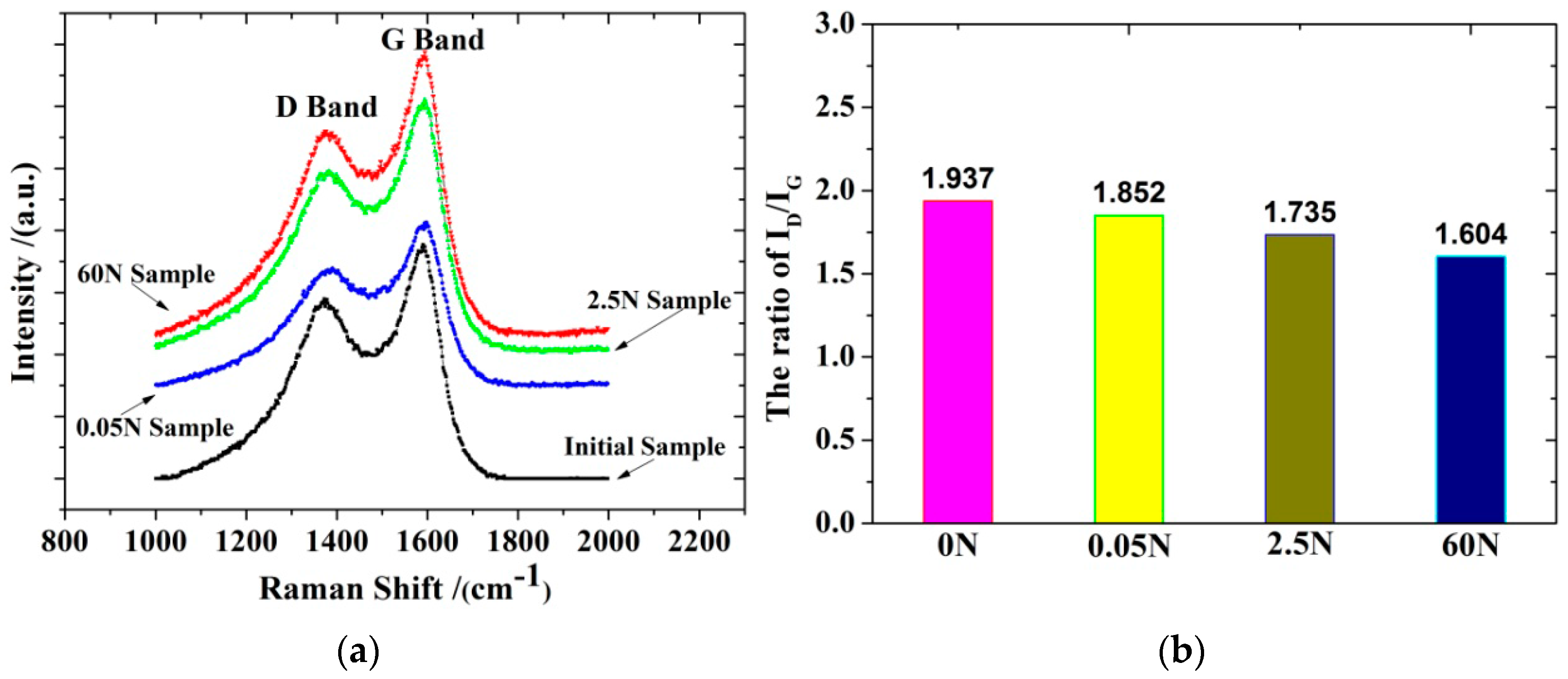
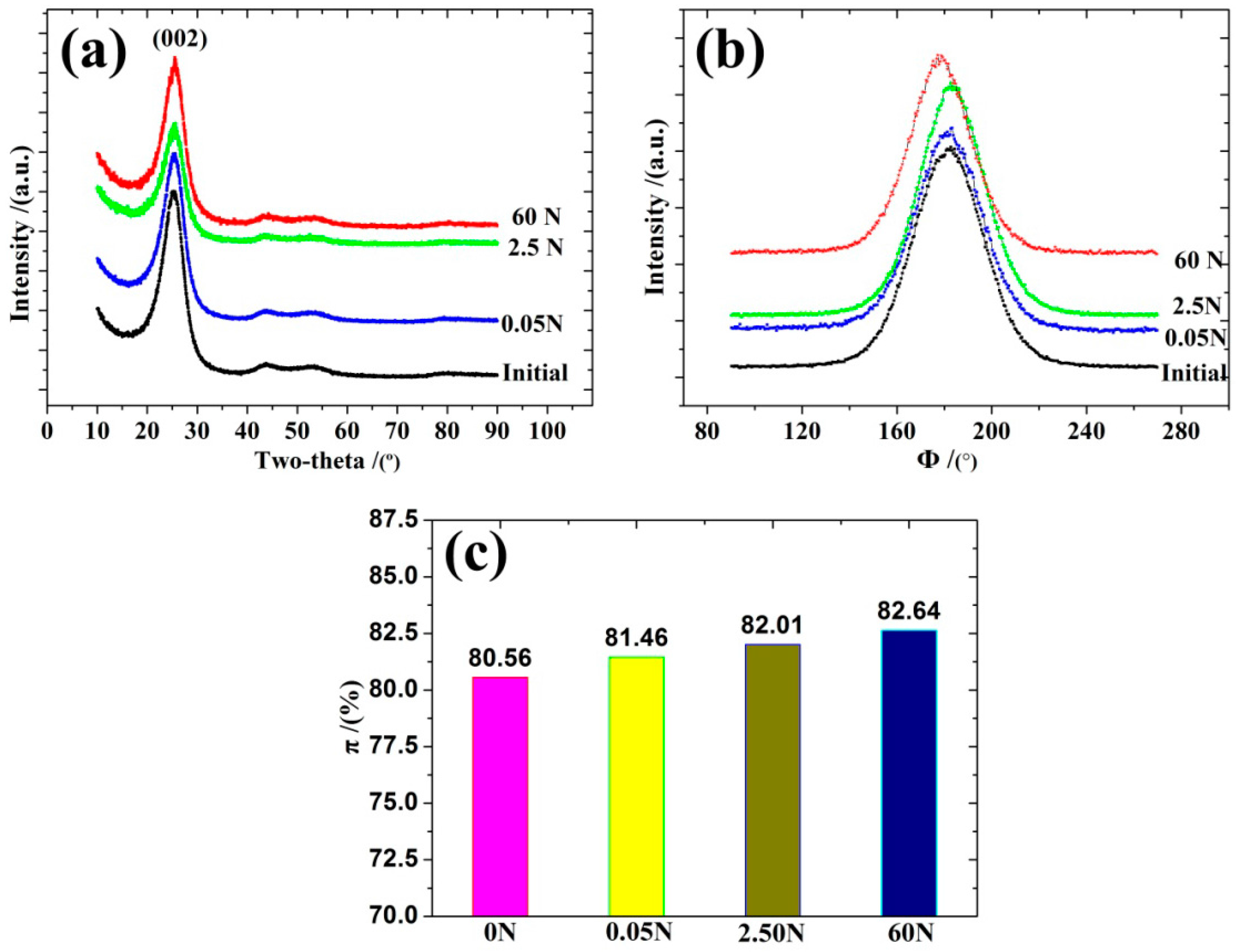
| Test Loads (N) | Test Status | Tested Results (°C−1) | Average (°C−1) | Initial Microstrain (με) | ||
|---|---|---|---|---|---|---|
| First Time | Second Time | Third Time | ||||
| 0.05 | Cooling | −5.30 × 10−7 | −5.42 × 10−7 | −5.32 × 10−7 | −4.72 × 10−7 | 1961 |
| Heating | −3.65 × 10−7 | −4.36 × 10−7 | −4.29 × 10−7 | |||
| Mean | −4.47 × 10−7 | −4.89 × 10−7 | −4.81 × 10−7 | |||
| 2.5 | Cooling | −4.79 × 10−7 | −4.67 × 10−7 | −4.60 × 10−7 | −5.26 × 10−7 | 1965 |
| Heating | −5.77 × 10−7 | −5.86 × 10−7 | −5.84 × 10−7 | |||
| Mean | −5.28 × 10−7 | −5.27 × 10−7 | −5.22 × 10−7 | |||
| 5 | Cooling | −5.06 × 10−7 | −4.97 × 10−7 | −4.89 × 10−7 | −5.50 × 10−7 | 2049 |
| Heating | −5.85 × 10−7 | −6.09 × 10−7 | −6.13 × 10−7 | |||
| Mean | −5.45 × 10−7 | −5.53 × 10−7 | −5.51 × 10−7 | |||
| 20 | Cooling | −6.97 × 10−7 | −6.77 × 10−7 | −6.35 × 10−7 | −6.71 × 10−7 | 2486 |
| Heating | −6.49 × 10−7 | −6.76 × 10−7 | −6.95 × 10−7 | |||
| Mean | −6.73 × 10−7 | −6.76 × 10−7 | −6.65 × 10−7 | |||
| 40 | Cooling | −1.14 × 10−6 | −1.11 × 10−6 | −1.08 × 10−6 | −9.58 × 10−7 | 2947 |
| Heating | −7.97 × 10−7 | −8.04 × 10−7 | −8.20 × 10−7 | |||
| Mean | −9.67 × 10−7 | −9.56 × 10−7 | −9.51 × 10−7 | |||
| 60 | Cooling | −1.23 × 10−6 | −1.13 × 10−6 | −1.09 × 10−6 | −1.13 × 10−6 | 3333 |
| Heating | −1.08 × 10−6 | −1.13 × 10−6 | −1.13 × 10−6 | |||
| Mean | −1.15 × 10−6 | −1.13 × 10−6 | −1.11 × 10−6 | |||
| Sample | νD/cm−1 | νG/cm−1 | WD/cm−1 | WG/cm−1 | ID/(ID + IG) |
|---|---|---|---|---|---|
| Initial | 1372 | 1590 | 266 | 109 | 0.6595 |
| 0.05 N | 1390 | 1595 | 260 | 107 | 0.6494 |
| 2.5 N | 1383 | 1590 | 258 | 106 | 0.6344 |
| 60 N | 1374 | 1589 | 217 | 103 | 0.6160 |
| Sample | 2θ/° | d002/nm | Lc/nm | Xc/% | Z/° |
|---|---|---|---|---|---|
| Initial | 25.527 | 0.3488 | 1.6901 | 66.79 | 17.4935 |
| 0.05 N | 25.577 | 0.3480 | 1.6962 | 68.93 | 16.6855 |
| 2.5 N | 25.624 | 0.3474 | 1.7188 | 70.45 | 16.1975 |
| 60 N | 25.749 | 0.3458 | 1.7290 | 73.27 | 15.6220 |
© 2018 by the authors. Licensee MDPI, Basel, Switzerland. This article is an open access article distributed under the terms and conditions of the Creative Commons Attribution (CC BY) license (http://creativecommons.org/licenses/by/4.0/).
Share and Cite
Geng, G.; Ma, X.; Geng, H.; Wu, Y. Effect of Load on the Thermal Expansion Behavior of T700 Carbon Fiber Bundles. Polymers 2018, 10, 152. https://doi.org/10.3390/polym10020152
Geng G, Ma X, Geng H, Wu Y. Effect of Load on the Thermal Expansion Behavior of T700 Carbon Fiber Bundles. Polymers. 2018; 10(2):152. https://doi.org/10.3390/polym10020152
Chicago/Turabian StyleGeng, Guoliang, Xiaofei Ma, Hongbin Geng, and Yiyong Wu. 2018. "Effect of Load on the Thermal Expansion Behavior of T700 Carbon Fiber Bundles" Polymers 10, no. 2: 152. https://doi.org/10.3390/polym10020152



